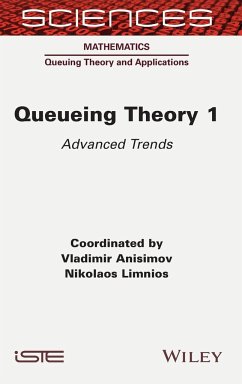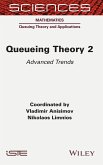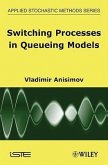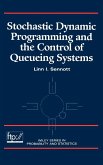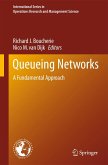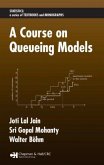Queueing Theory 1
Advanced Trends
Mitwirkender: Anisimov, Vladimir; Limnios, Nikolaos
Queueing Theory 1
Advanced Trends
Mitwirkender: Anisimov, Vladimir; Limnios, Nikolaos
- Gebundenes Buch
- Merkliste
- Auf die Merkliste
- Bewerten Bewerten
- Teilen
- Produkt teilen
- Produkterinnerung
- Produkterinnerung
The aim of this book is to reflect the current cutting-edge thinking and established practices in the investigation of queueing systems and networks. This first volume includes ten chapters written by experts well-known in their areas. The book studies the analysis of queues with interdependent arrival and service times, characteristics of fluid queues, modifications of retrial queueing systems and finite-source retrial queues with random breakdowns, repairs and customers' collisions. Some recent tendencies in the asymptotic analysis include the average and diffusion approximation of Markov…mehr
Andere Kunden interessierten sich auch für
![Queueing Theory 2 Queueing Theory 2]() Vladimir AnisimovQueueing Theory 2177,99 €
Vladimir AnisimovQueueing Theory 2177,99 €![Switching Processes in Queueing Models Switching Processes in Queueing Models]() Vladimir AnisimovSwitching Processes in Queueing Models202,99 €
Vladimir AnisimovSwitching Processes in Queueing Models202,99 €![Stochastic Dynamic Programming and the Control of Queueing Systems Stochastic Dynamic Programming and the Control of Queueing Systems]() Linn I. SennottStochastic Dynamic Programming and the Control of Queueing Systems205,99 €
Linn I. SennottStochastic Dynamic Programming and the Control of Queueing Systems205,99 €![Queueing Networks Queueing Networks]() Queueing Networks150,99 €
Queueing Networks150,99 €![Queueing Systems, Volume I Queueing Systems, Volume I]() Leonard KleinrockQueueing Systems, Volume I179,99 €
Leonard KleinrockQueueing Systems, Volume I179,99 €![Multiproduct Queueing Networks With Deterministic Routing Multiproduct Queueing Networks With Deterministic Routing]() Gabriel R BitranMultiproduct Queueing Networks With Deterministic Routing28,99 €
Gabriel R BitranMultiproduct Queueing Networks With Deterministic Routing28,99 €![A Course on Queueing Models A Course on Queueing Models]() Joti Lal JainA Course on Queueing Models180,99 €
Joti Lal JainA Course on Queueing Models180,99 €-
-
-
The aim of this book is to reflect the current cutting-edge thinking and established practices in the investigation of queueing systems and networks. This first volume includes ten chapters written by experts well-known in their areas. The book studies the analysis of queues with interdependent arrival and service times, characteristics of fluid queues, modifications of retrial queueing systems and finite-source retrial queues with random breakdowns, repairs and customers' collisions. Some recent tendencies in the asymptotic analysis include the average and diffusion approximation of Markov queueing systems and networks, the diffusion and Gaussian limits of multi-channel queueing networks with rather general input flow, and the analysis of two-time-scale nonhomogenous Markov chains using the large deviations principle. The book also analyzes transient behavior of infinite-server queueing models with a mixed arrival process, the strong stability of queueing systems and networks, and applications of fast simulation methods for solving high-dimension combinatorial problems.
Hinweis: Dieser Artikel kann nur an eine deutsche Lieferadresse ausgeliefert werden.
Hinweis: Dieser Artikel kann nur an eine deutsche Lieferadresse ausgeliefert werden.
Produktdetails
- Produktdetails
- Verlag: Wiley
- Seitenzahl: 336
- Erscheinungstermin: 13. April 2021
- Englisch
- Abmessung: 240mm x 161mm x 22mm
- Gewicht: 665g
- ISBN-13: 9781789450019
- ISBN-10: 1789450012
- Artikelnr.: 60010391
- Herstellerkennzeichnung
- Libri GmbH
- Europaallee 1
- 36244 Bad Hersfeld
- gpsr@libri.de
- Verlag: Wiley
- Seitenzahl: 336
- Erscheinungstermin: 13. April 2021
- Englisch
- Abmessung: 240mm x 161mm x 22mm
- Gewicht: 665g
- ISBN-13: 9781789450019
- ISBN-10: 1789450012
- Artikelnr.: 60010391
- Herstellerkennzeichnung
- Libri GmbH
- Europaallee 1
- 36244 Bad Hersfeld
- gpsr@libri.de
Vladimir Anisimov is Full Professor in Applied Statistics. He works in the Center for Design & Analysis at Amgen Inc. in London, UK. His research interests include probability models and stochastic processes, clinical trials modeling, applied statistics, queueing models and asymptotic techniques. Nikolaos Limnios is Full Professor in Applied Mathematics at the University of Technology of Compiègne, part of the Sorbonne University Group, in France. His research interests include stochastic processes and statistics, Markov and semi-Markov processes, random evolutions with applications in reliability, queueing systems, earthquakes and biology.
Preface xi Chapter 1. Discrete Time Single-server Queues with Interdependent Interarrival and Service Times 1 Attahiru Sule ALFA 1.1. Introduction 1 1.2. The Geo/Geo/1 case 3 1.2.1. Arrival probability as a function of service completion probability 4 1.2.2. Service times dependent on interarrival times 6 1.3. The PH/PH/1 case 7 1.3.1. A review of discrete PH distribution 7 1.3.2. The PH/PH/1 system 9 1.4. The model with multiple interarrival time distributions 10 1.4.1. Preliminaries 11 1.4.2. A queueing model with interarrival times dependent on service times 13 1.5. Interdependent interarrival and service times 15 1.5.1. A discrete time queueing model with bivariate geometric distribution 16 1.5.2. Matrix equivalent model 17 1.6. Conclusion 18 1.7. Acknowledgements 18 1.8. References 18 Chapter 2. Busy Period, Congestion Analysis and Loss Probability in Fluid Queues 21 Fabrice GUILLEMIN, Marie-Ange REMICHE and Bruno SERICOLA 2.1. Introduction 21 2.2. Modeling a link under congestion and buffer fluctuations 24 2.2.1. Model description 25 2.2.2. Peaks and valleys 26 2.2.3. Minimum valley height in a busy period 28 2.2.4. Maximum peak level in a busy period 33 2.2.5. Maximum peak under a fixed fluid level 37 2.3. Fluid queue with finite buffer 42 2.3.1. Congestion metrics 42 2.3.2. Minimum valley height in a busy period 43 2.3.3. Reduction of the state space 46 2.3.4. Distributions of
1(x) and V1(x) 47 2.3.5. Sequences of idle and busy periods 49 2.3.6. Joint distributions of loss periods and loss volumes 51 2.3.7. Total duration of losses and volume of information lost 56 2.4. Conclusion 59 2.5. References 60 Chapter 3. Diffusion Approximation of Queueing Systems and Networks 63 Dimitri KOROLIOUK and Vladimir S. KOROLIUK 3.1. Introduction 63 3.2. Markov queueing processes 64 3.3. Average and diffusion approximation 65 3.3.1. Average scheme 65 3.3.2. Diffusion approximation scheme 68 3.3.3. Stationary distribution 73 3.4. Markov queueing systems 78 3.4.1. Collective limit theorem in R1 78 3.4.2. Systems of M/M type 81 3.4.3. Repairman problem 82 3.5. Markov queueing networks 85 3.5.1. Collective limit theorems in RN 85 3.5.2. Markov queueing networks 89 3.5.3. Superposition of Markov processes 91 3.6. Semi-Markov queueing systems 92 3.7. Acknowledgements 96 3.8. References 96 Chapter 4. First-come First-served Retrial Queueing System by Laszlo Lakatos and its Modifications 97 Igor Nikolaevich KOVALENKO
4.1. Introduction 97 4.2. A contribution by Laszlo Lakatos and his disciples 98 4.3. A contribution by E.V. Koba 98 4.4. An Erlangian and hyper-Erlangian approximation for a Laszlo Lakatos-type queueing system 99 4.5. Two models with a combined queueing discipline 102 4.6. References 104 Chapter 5. Parameter Mixing in Infinite-server Queues 107 Lucas VAN KREVELD and Onno BOXMA 5.1. Introduction 107 5.2. The M
/Coxn/
queue 109 5.2.1. The differential equation 110 5.2.2. Calculating moments 113 5.2.3. Steady state 120 5.2.4. M
/M/
125 5.3. Mixing in Markov-modulated infinite-server queues 131 5.3.1. The differential equation 131 5.3.2. Calculating moments 133 5.4. Discussion and future work 142 5.5. References 143 Chapter 6. Application of Fast Simulation Methods of Queueing Theory for Solving Some High-dimension Combinatorial Problems 145 Igor KUZNETSOV and Nickolay KUZNETSOV 6.1. Introduction 146 6.2. Upper and lower bounds for the number of some k-dimensional subspaces of a given weight over a finite field 147 6.2.1. A general fast simulation algorithm 149 6.2.2. An auxiliary algorithm 153 6.2.3. Exact analytical formulae for the cases k = 1 and k = 2 155 6.2.4. The upper and lower bounds for the probability P{Y
(r)} 158 6.2.5. Numerical results 164 6.3. Evaluation of the number of "good" permutations by fast simulation on the SCIT-4 multiprocessor computer complex 167 6.3.1. Modified fast simulation method 168 6.3.2. Numerical results 171 6.4. References 174 Chapter 7. Diffusion and Gaussian Limits for Multichannel Queueing Networks 177 Eugene LEBEDEV and Hanna LIVINSKA 7.1. Introduction 177 7.2. Model description and notation 182 7.3. Local approach to prove limit theorems 184 7.3.1. Network of the [GI M
]r-type in heavy traffic 185 7.4. Limit theorems for networks with controlled input flow 190 7.4.1. Diffusion approximation of [SM M
]r-networks 190 7.4.2. Asymptotics of stationary distribution for [SM GI
]r-networks 192 7.4.3. Convergence to Ornstein-Uhlenbeck process 194 7.5. Gaussian approximation of networks with input flow of general structure 195 7.5.1. Gaussian approximation of [G M
]r-networks 195 7.5.2. Criterion of Markovian behavior for r-dimensional Gaussian processes 197 7.5.3. Non-Markov Gaussian approximation of [G GI
]r-networks 198 7.6. Limit processes for network with time-dependent input flow 201 7.6.1. Gaussian approximation of [Mt M
]r -networks in heavy traffic 201 7.6.2. Limit process in case of asymptotically large initial load 205 7.7. Conclusion 207 7.8. Acknowledgements 208 7.9. References 208 Chapter 8. Recent Results in Finite-source Retrial Queues with Collisions 213 Anatoly NAZAROV, János SZTRIK and Anna KVACH 8.1. Introduction 213 8.2. Model description and notations 216 8.3. Systems with a reliable server 220 8.3.1. M/M/1 systems 220 8.3.2. M/GI/1 system 224 8.4. Systems with an unreliable server 229 8.4.1. M/M/1 system 229 8.4.2. M/GI/1 system 237 8.4.3. Stochastic simulation of special systems 240 8.4.4. Gamma distributed retrial times 242 8.4.5. The effect of breakdowns disciplines 243 8.5. Conclusion 251 8.6. Acknowledgments 253 8.7. References 253 Chapter 9. Strong Stability of Queueing Systems and Networks: a Survey and Perspectives 259 Boualem RABTA, Ouiza LEKADIR and Djamil AÏSSANI 9.1. Introduction 259 9.2. Preliminary and notations 261 9.3. Strong stability of queueing systems 263 9.3.1. M/M/1 queue 264 9.3.2. PH/M/1 and M/PH/1 queues 269 9.3.3. G/M/1 and M/G/1 queues 270 9.3.4. Other queues 276 9.3.5. Queueing networks 277 9.3.6. Non-parametric perturbation 286 9.4. Conclusion and further directions 287 9.5. References 287 Chapter 10. Time-varying Queues: a Two-time-scale Approach 293 George YIN, Hanqin ZHANG and Qing ZHANG 10.1. Introduction 293 10.2. Time-varying queues 295 10.3. Main results 298 10.3.1. Large deviations of two-time-scale queues 298 10.3.2. Computation of H(y, t) 301 10.3.3. Applications to queueing systems 303 10.4. Concluding remarks 309 10.5. References 310 List of Authors 313 Index 315
1(x) and V1(x) 47 2.3.5. Sequences of idle and busy periods 49 2.3.6. Joint distributions of loss periods and loss volumes 51 2.3.7. Total duration of losses and volume of information lost 56 2.4. Conclusion 59 2.5. References 60 Chapter 3. Diffusion Approximation of Queueing Systems and Networks 63 Dimitri KOROLIOUK and Vladimir S. KOROLIUK 3.1. Introduction 63 3.2. Markov queueing processes 64 3.3. Average and diffusion approximation 65 3.3.1. Average scheme 65 3.3.2. Diffusion approximation scheme 68 3.3.3. Stationary distribution 73 3.4. Markov queueing systems 78 3.4.1. Collective limit theorem in R1 78 3.4.2. Systems of M/M type 81 3.4.3. Repairman problem 82 3.5. Markov queueing networks 85 3.5.1. Collective limit theorems in RN 85 3.5.2. Markov queueing networks 89 3.5.3. Superposition of Markov processes 91 3.6. Semi-Markov queueing systems 92 3.7. Acknowledgements 96 3.8. References 96 Chapter 4. First-come First-served Retrial Queueing System by Laszlo Lakatos and its Modifications 97 Igor Nikolaevich KOVALENKO
4.1. Introduction 97 4.2. A contribution by Laszlo Lakatos and his disciples 98 4.3. A contribution by E.V. Koba 98 4.4. An Erlangian and hyper-Erlangian approximation for a Laszlo Lakatos-type queueing system 99 4.5. Two models with a combined queueing discipline 102 4.6. References 104 Chapter 5. Parameter Mixing in Infinite-server Queues 107 Lucas VAN KREVELD and Onno BOXMA 5.1. Introduction 107 5.2. The M
/Coxn/
queue 109 5.2.1. The differential equation 110 5.2.2. Calculating moments 113 5.2.3. Steady state 120 5.2.4. M
/M/
125 5.3. Mixing in Markov-modulated infinite-server queues 131 5.3.1. The differential equation 131 5.3.2. Calculating moments 133 5.4. Discussion and future work 142 5.5. References 143 Chapter 6. Application of Fast Simulation Methods of Queueing Theory for Solving Some High-dimension Combinatorial Problems 145 Igor KUZNETSOV and Nickolay KUZNETSOV 6.1. Introduction 146 6.2. Upper and lower bounds for the number of some k-dimensional subspaces of a given weight over a finite field 147 6.2.1. A general fast simulation algorithm 149 6.2.2. An auxiliary algorithm 153 6.2.3. Exact analytical formulae for the cases k = 1 and k = 2 155 6.2.4. The upper and lower bounds for the probability P{Y
(r)} 158 6.2.5. Numerical results 164 6.3. Evaluation of the number of "good" permutations by fast simulation on the SCIT-4 multiprocessor computer complex 167 6.3.1. Modified fast simulation method 168 6.3.2. Numerical results 171 6.4. References 174 Chapter 7. Diffusion and Gaussian Limits for Multichannel Queueing Networks 177 Eugene LEBEDEV and Hanna LIVINSKA 7.1. Introduction 177 7.2. Model description and notation 182 7.3. Local approach to prove limit theorems 184 7.3.1. Network of the [GI M
]r-type in heavy traffic 185 7.4. Limit theorems for networks with controlled input flow 190 7.4.1. Diffusion approximation of [SM M
]r-networks 190 7.4.2. Asymptotics of stationary distribution for [SM GI
]r-networks 192 7.4.3. Convergence to Ornstein-Uhlenbeck process 194 7.5. Gaussian approximation of networks with input flow of general structure 195 7.5.1. Gaussian approximation of [G M
]r-networks 195 7.5.2. Criterion of Markovian behavior for r-dimensional Gaussian processes 197 7.5.3. Non-Markov Gaussian approximation of [G GI
]r-networks 198 7.6. Limit processes for network with time-dependent input flow 201 7.6.1. Gaussian approximation of [Mt M
]r -networks in heavy traffic 201 7.6.2. Limit process in case of asymptotically large initial load 205 7.7. Conclusion 207 7.8. Acknowledgements 208 7.9. References 208 Chapter 8. Recent Results in Finite-source Retrial Queues with Collisions 213 Anatoly NAZAROV, János SZTRIK and Anna KVACH 8.1. Introduction 213 8.2. Model description and notations 216 8.3. Systems with a reliable server 220 8.3.1. M/M/1 systems 220 8.3.2. M/GI/1 system 224 8.4. Systems with an unreliable server 229 8.4.1. M/M/1 system 229 8.4.2. M/GI/1 system 237 8.4.3. Stochastic simulation of special systems 240 8.4.4. Gamma distributed retrial times 242 8.4.5. The effect of breakdowns disciplines 243 8.5. Conclusion 251 8.6. Acknowledgments 253 8.7. References 253 Chapter 9. Strong Stability of Queueing Systems and Networks: a Survey and Perspectives 259 Boualem RABTA, Ouiza LEKADIR and Djamil AÏSSANI 9.1. Introduction 259 9.2. Preliminary and notations 261 9.3. Strong stability of queueing systems 263 9.3.1. M/M/1 queue 264 9.3.2. PH/M/1 and M/PH/1 queues 269 9.3.3. G/M/1 and M/G/1 queues 270 9.3.4. Other queues 276 9.3.5. Queueing networks 277 9.3.6. Non-parametric perturbation 286 9.4. Conclusion and further directions 287 9.5. References 287 Chapter 10. Time-varying Queues: a Two-time-scale Approach 293 George YIN, Hanqin ZHANG and Qing ZHANG 10.1. Introduction 293 10.2. Time-varying queues 295 10.3. Main results 298 10.3.1. Large deviations of two-time-scale queues 298 10.3.2. Computation of H(y, t) 301 10.3.3. Applications to queueing systems 303 10.4. Concluding remarks 309 10.5. References 310 List of Authors 313 Index 315
Preface xi Chapter 1. Discrete Time Single-server Queues with Interdependent Interarrival and Service Times 1 Attahiru Sule ALFA 1.1. Introduction 1 1.2. The Geo/Geo/1 case 3 1.2.1. Arrival probability as a function of service completion probability 4 1.2.2. Service times dependent on interarrival times 6 1.3. The PH/PH/1 case 7 1.3.1. A review of discrete PH distribution 7 1.3.2. The PH/PH/1 system 9 1.4. The model with multiple interarrival time distributions 10 1.4.1. Preliminaries 11 1.4.2. A queueing model with interarrival times dependent on service times 13 1.5. Interdependent interarrival and service times 15 1.5.1. A discrete time queueing model with bivariate geometric distribution 16 1.5.2. Matrix equivalent model 17 1.6. Conclusion 18 1.7. Acknowledgements 18 1.8. References 18 Chapter 2. Busy Period, Congestion Analysis and Loss Probability in Fluid Queues 21 Fabrice GUILLEMIN, Marie-Ange REMICHE and Bruno SERICOLA 2.1. Introduction 21 2.2. Modeling a link under congestion and buffer fluctuations 24 2.2.1. Model description 25 2.2.2. Peaks and valleys 26 2.2.3. Minimum valley height in a busy period 28 2.2.4. Maximum peak level in a busy period 33 2.2.5. Maximum peak under a fixed fluid level 37 2.3. Fluid queue with finite buffer 42 2.3.1. Congestion metrics 42 2.3.2. Minimum valley height in a busy period 43 2.3.3. Reduction of the state space 46 2.3.4. Distributions of
1(x) and V1(x) 47 2.3.5. Sequences of idle and busy periods 49 2.3.6. Joint distributions of loss periods and loss volumes 51 2.3.7. Total duration of losses and volume of information lost 56 2.4. Conclusion 59 2.5. References 60 Chapter 3. Diffusion Approximation of Queueing Systems and Networks 63 Dimitri KOROLIOUK and Vladimir S. KOROLIUK 3.1. Introduction 63 3.2. Markov queueing processes 64 3.3. Average and diffusion approximation 65 3.3.1. Average scheme 65 3.3.2. Diffusion approximation scheme 68 3.3.3. Stationary distribution 73 3.4. Markov queueing systems 78 3.4.1. Collective limit theorem in R1 78 3.4.2. Systems of M/M type 81 3.4.3. Repairman problem 82 3.5. Markov queueing networks 85 3.5.1. Collective limit theorems in RN 85 3.5.2. Markov queueing networks 89 3.5.3. Superposition of Markov processes 91 3.6. Semi-Markov queueing systems 92 3.7. Acknowledgements 96 3.8. References 96 Chapter 4. First-come First-served Retrial Queueing System by Laszlo Lakatos and its Modifications 97 Igor Nikolaevich KOVALENKO
4.1. Introduction 97 4.2. A contribution by Laszlo Lakatos and his disciples 98 4.3. A contribution by E.V. Koba 98 4.4. An Erlangian and hyper-Erlangian approximation for a Laszlo Lakatos-type queueing system 99 4.5. Two models with a combined queueing discipline 102 4.6. References 104 Chapter 5. Parameter Mixing in Infinite-server Queues 107 Lucas VAN KREVELD and Onno BOXMA 5.1. Introduction 107 5.2. The M
/Coxn/
queue 109 5.2.1. The differential equation 110 5.2.2. Calculating moments 113 5.2.3. Steady state 120 5.2.4. M
/M/
125 5.3. Mixing in Markov-modulated infinite-server queues 131 5.3.1. The differential equation 131 5.3.2. Calculating moments 133 5.4. Discussion and future work 142 5.5. References 143 Chapter 6. Application of Fast Simulation Methods of Queueing Theory for Solving Some High-dimension Combinatorial Problems 145 Igor KUZNETSOV and Nickolay KUZNETSOV 6.1. Introduction 146 6.2. Upper and lower bounds for the number of some k-dimensional subspaces of a given weight over a finite field 147 6.2.1. A general fast simulation algorithm 149 6.2.2. An auxiliary algorithm 153 6.2.3. Exact analytical formulae for the cases k = 1 and k = 2 155 6.2.4. The upper and lower bounds for the probability P{Y
(r)} 158 6.2.5. Numerical results 164 6.3. Evaluation of the number of "good" permutations by fast simulation on the SCIT-4 multiprocessor computer complex 167 6.3.1. Modified fast simulation method 168 6.3.2. Numerical results 171 6.4. References 174 Chapter 7. Diffusion and Gaussian Limits for Multichannel Queueing Networks 177 Eugene LEBEDEV and Hanna LIVINSKA 7.1. Introduction 177 7.2. Model description and notation 182 7.3. Local approach to prove limit theorems 184 7.3.1. Network of the [GI M
]r-type in heavy traffic 185 7.4. Limit theorems for networks with controlled input flow 190 7.4.1. Diffusion approximation of [SM M
]r-networks 190 7.4.2. Asymptotics of stationary distribution for [SM GI
]r-networks 192 7.4.3. Convergence to Ornstein-Uhlenbeck process 194 7.5. Gaussian approximation of networks with input flow of general structure 195 7.5.1. Gaussian approximation of [G M
]r-networks 195 7.5.2. Criterion of Markovian behavior for r-dimensional Gaussian processes 197 7.5.3. Non-Markov Gaussian approximation of [G GI
]r-networks 198 7.6. Limit processes for network with time-dependent input flow 201 7.6.1. Gaussian approximation of [Mt M
]r -networks in heavy traffic 201 7.6.2. Limit process in case of asymptotically large initial load 205 7.7. Conclusion 207 7.8. Acknowledgements 208 7.9. References 208 Chapter 8. Recent Results in Finite-source Retrial Queues with Collisions 213 Anatoly NAZAROV, János SZTRIK and Anna KVACH 8.1. Introduction 213 8.2. Model description and notations 216 8.3. Systems with a reliable server 220 8.3.1. M/M/1 systems 220 8.3.2. M/GI/1 system 224 8.4. Systems with an unreliable server 229 8.4.1. M/M/1 system 229 8.4.2. M/GI/1 system 237 8.4.3. Stochastic simulation of special systems 240 8.4.4. Gamma distributed retrial times 242 8.4.5. The effect of breakdowns disciplines 243 8.5. Conclusion 251 8.6. Acknowledgments 253 8.7. References 253 Chapter 9. Strong Stability of Queueing Systems and Networks: a Survey and Perspectives 259 Boualem RABTA, Ouiza LEKADIR and Djamil AÏSSANI 9.1. Introduction 259 9.2. Preliminary and notations 261 9.3. Strong stability of queueing systems 263 9.3.1. M/M/1 queue 264 9.3.2. PH/M/1 and M/PH/1 queues 269 9.3.3. G/M/1 and M/G/1 queues 270 9.3.4. Other queues 276 9.3.5. Queueing networks 277 9.3.6. Non-parametric perturbation 286 9.4. Conclusion and further directions 287 9.5. References 287 Chapter 10. Time-varying Queues: a Two-time-scale Approach 293 George YIN, Hanqin ZHANG and Qing ZHANG 10.1. Introduction 293 10.2. Time-varying queues 295 10.3. Main results 298 10.3.1. Large deviations of two-time-scale queues 298 10.3.2. Computation of H(y, t) 301 10.3.3. Applications to queueing systems 303 10.4. Concluding remarks 309 10.5. References 310 List of Authors 313 Index 315
1(x) and V1(x) 47 2.3.5. Sequences of idle and busy periods 49 2.3.6. Joint distributions of loss periods and loss volumes 51 2.3.7. Total duration of losses and volume of information lost 56 2.4. Conclusion 59 2.5. References 60 Chapter 3. Diffusion Approximation of Queueing Systems and Networks 63 Dimitri KOROLIOUK and Vladimir S. KOROLIUK 3.1. Introduction 63 3.2. Markov queueing processes 64 3.3. Average and diffusion approximation 65 3.3.1. Average scheme 65 3.3.2. Diffusion approximation scheme 68 3.3.3. Stationary distribution 73 3.4. Markov queueing systems 78 3.4.1. Collective limit theorem in R1 78 3.4.2. Systems of M/M type 81 3.4.3. Repairman problem 82 3.5. Markov queueing networks 85 3.5.1. Collective limit theorems in RN 85 3.5.2. Markov queueing networks 89 3.5.3. Superposition of Markov processes 91 3.6. Semi-Markov queueing systems 92 3.7. Acknowledgements 96 3.8. References 96 Chapter 4. First-come First-served Retrial Queueing System by Laszlo Lakatos and its Modifications 97 Igor Nikolaevich KOVALENKO
4.1. Introduction 97 4.2. A contribution by Laszlo Lakatos and his disciples 98 4.3. A contribution by E.V. Koba 98 4.4. An Erlangian and hyper-Erlangian approximation for a Laszlo Lakatos-type queueing system 99 4.5. Two models with a combined queueing discipline 102 4.6. References 104 Chapter 5. Parameter Mixing in Infinite-server Queues 107 Lucas VAN KREVELD and Onno BOXMA 5.1. Introduction 107 5.2. The M
/Coxn/
queue 109 5.2.1. The differential equation 110 5.2.2. Calculating moments 113 5.2.3. Steady state 120 5.2.4. M
/M/
125 5.3. Mixing in Markov-modulated infinite-server queues 131 5.3.1. The differential equation 131 5.3.2. Calculating moments 133 5.4. Discussion and future work 142 5.5. References 143 Chapter 6. Application of Fast Simulation Methods of Queueing Theory for Solving Some High-dimension Combinatorial Problems 145 Igor KUZNETSOV and Nickolay KUZNETSOV 6.1. Introduction 146 6.2. Upper and lower bounds for the number of some k-dimensional subspaces of a given weight over a finite field 147 6.2.1. A general fast simulation algorithm 149 6.2.2. An auxiliary algorithm 153 6.2.3. Exact analytical formulae for the cases k = 1 and k = 2 155 6.2.4. The upper and lower bounds for the probability P{Y
(r)} 158 6.2.5. Numerical results 164 6.3. Evaluation of the number of "good" permutations by fast simulation on the SCIT-4 multiprocessor computer complex 167 6.3.1. Modified fast simulation method 168 6.3.2. Numerical results 171 6.4. References 174 Chapter 7. Diffusion and Gaussian Limits for Multichannel Queueing Networks 177 Eugene LEBEDEV and Hanna LIVINSKA 7.1. Introduction 177 7.2. Model description and notation 182 7.3. Local approach to prove limit theorems 184 7.3.1. Network of the [GI M
]r-type in heavy traffic 185 7.4. Limit theorems for networks with controlled input flow 190 7.4.1. Diffusion approximation of [SM M
]r-networks 190 7.4.2. Asymptotics of stationary distribution for [SM GI
]r-networks 192 7.4.3. Convergence to Ornstein-Uhlenbeck process 194 7.5. Gaussian approximation of networks with input flow of general structure 195 7.5.1. Gaussian approximation of [G M
]r-networks 195 7.5.2. Criterion of Markovian behavior for r-dimensional Gaussian processes 197 7.5.3. Non-Markov Gaussian approximation of [G GI
]r-networks 198 7.6. Limit processes for network with time-dependent input flow 201 7.6.1. Gaussian approximation of [Mt M
]r -networks in heavy traffic 201 7.6.2. Limit process in case of asymptotically large initial load 205 7.7. Conclusion 207 7.8. Acknowledgements 208 7.9. References 208 Chapter 8. Recent Results in Finite-source Retrial Queues with Collisions 213 Anatoly NAZAROV, János SZTRIK and Anna KVACH 8.1. Introduction 213 8.2. Model description and notations 216 8.3. Systems with a reliable server 220 8.3.1. M/M/1 systems 220 8.3.2. M/GI/1 system 224 8.4. Systems with an unreliable server 229 8.4.1. M/M/1 system 229 8.4.2. M/GI/1 system 237 8.4.3. Stochastic simulation of special systems 240 8.4.4. Gamma distributed retrial times 242 8.4.5. The effect of breakdowns disciplines 243 8.5. Conclusion 251 8.6. Acknowledgments 253 8.7. References 253 Chapter 9. Strong Stability of Queueing Systems and Networks: a Survey and Perspectives 259 Boualem RABTA, Ouiza LEKADIR and Djamil AÏSSANI 9.1. Introduction 259 9.2. Preliminary and notations 261 9.3. Strong stability of queueing systems 263 9.3.1. M/M/1 queue 264 9.3.2. PH/M/1 and M/PH/1 queues 269 9.3.3. G/M/1 and M/G/1 queues 270 9.3.4. Other queues 276 9.3.5. Queueing networks 277 9.3.6. Non-parametric perturbation 286 9.4. Conclusion and further directions 287 9.5. References 287 Chapter 10. Time-varying Queues: a Two-time-scale Approach 293 George YIN, Hanqin ZHANG and Qing ZHANG 10.1. Introduction 293 10.2. Time-varying queues 295 10.3. Main results 298 10.3.1. Large deviations of two-time-scale queues 298 10.3.2. Computation of H(y, t) 301 10.3.3. Applications to queueing systems 303 10.4. Concluding remarks 309 10.5. References 310 List of Authors 313 Index 315

